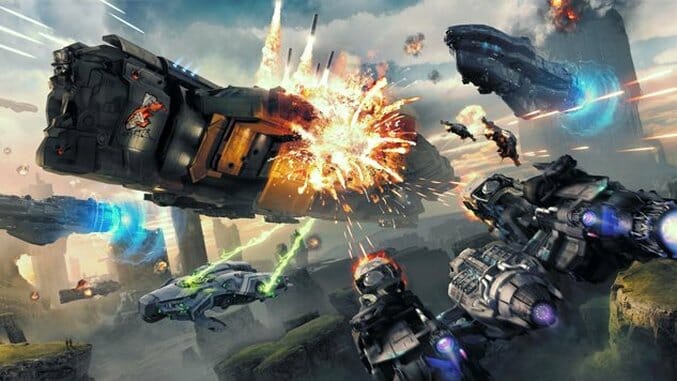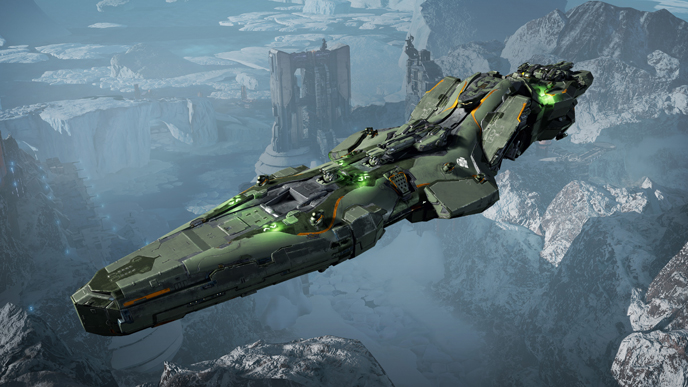
Of the many power fantasies popular videogames allow us to explore, one has had a surprisingly tough time breaking into the mainstream: that of piloting a giant spaceship in battles with other giant spaceships.
An MMO like Eve: Online might tap into this desire, though hopes of an immersive, harrowing experience might be dashed by its mercantile systems and mid-combat statistical calculations. Alternatively, newer space-set MOBAs like Fractured Space might eventually scratch players’ collective cruiser-controlling itch, but at the moment this is still a niche space in games yet to be definitively conquered. Enter Yager Development, who aim to conquer such a space with Dreadnought, their free-to-play, long-in-beta title for PC and PlayStation 4.
Yager is best known for their 2012 military shooter, Spec Ops: The Line, which one might recognize as the furthest conceptual thing from a giant spaceship combat sim. Peter Holzapfel, Dreadnought’s director who joined Yager in 2013, claims Spec Ops was important inspiration in the conception of the spaceship game; he says the goal was to create another accessible shooter with a major twist, à la Spec Ops. In this case, Dreadnought’s “twist” would simply be that the player controls a giant spaceship instead of a soldier. “Though it’s not as obvious,” he explained, “[Dreadnought] is a similar beast because in essence it’s a shooter, but it’s a shooter with giant spaceships.”
When he casually made this comparison to me and a handful of other journalists, my immediate reaction was that it was just marketing spin, if not outright bullshit than at least a promotional line that the game itself would only thinly support. However, once I got my hands on the game, I realized I was making too much of the analogy. I should have better tried to absorb its general sentiment: Dreadnought is a genuinely novel shooter, too.
The first thing to suggest Holzapfel’s comparison might be apt was just how familiar many of the game’s basics felt. As soon as we launched into a training round I picked a pre-made tank-equivalent class, sprinted (boosted) into battle, took cover behind large objects and aimed with the left trigger while firing with the right. It was like I was in high school again, playing a straightforward online FPS, only I was navigating a massive 360-degree space and cautiously managing my Destroyer’s energy consumption. Next, we jumped into a live game of Team Deathmatch mostly populated by participants of Dreadnought’s closed beta.
If the idea of energy management sounds intimidating, fear not, for it’s no harder than managing a cooldown meter in any other game. Still, players need to pay attention to their energy levels if they want a chance at living through PvP encounters. Each ship can allocate a limited but rechargable amount of energy toward their weapons, engines or shields at any time. It’s not hard to know when to engage each, as nothing but a well-timed shield boost can block those missiles coming your way, and only your boosted engines can get you to safety fast enough. When it’s time to attack, flood your main guns with power and let that enemy artillery cruiser or corvette have it— though you should make sure to cancel any active energy consumption once safe. The energy options are intuitively mapped to the PS4’s touchpad, whose broad thumb swipes are a satisfying analogue to one’s arm reaching across a control panel at your ship’s helm.
TDM and the PS4-exclusive, PvE Havoc mode not only taught our team the importance of energy management, but also reminded us to stay as a team in the first place. Like in any other shooter, lone wolves won’t last long, especially when pit against an organized team making full use of healing beams, energy missiles and concentrated group fire. Luckily for any who must learn that lesson, respawning is nearly instantaneous. In TDM, you pick which ship/class you want to return as and jump back into the action. In Havoc, where players only have one life per round, you can quickly come back as a small starfighter to help turn the tide for your hulking, still-living comrades.
As soon as we put the controllers down, my main takeaway was simple. “Anyone with shooter experience should have no problem picking this up.” Then, just before we left, we were shown the progression trees in full. Not only were there myriad upgrades found in each ship’s tech tree—and there are currently over 50 ships—players build three levels of fleets, namely “recruit,” “veteran” and “legendary” ones. Within each fleet are five ships, which themselves are broken down into five stat-based tiers. In other words, this game wants to provide enough incentive to its players to keep them around for quite some time.
By the time I left the event, I was sure I better understood what Dreadnought is: a reasonably accessive, free-to-play shooter whose scale of progression aims to match the scale of its ships.
Dreadnought has been in beta since since April 2016, and is set to officially release sometime later this year.
Peter Amato is a former intern for Paste Magazine. He’s on Twitter @Peter_Amato.

